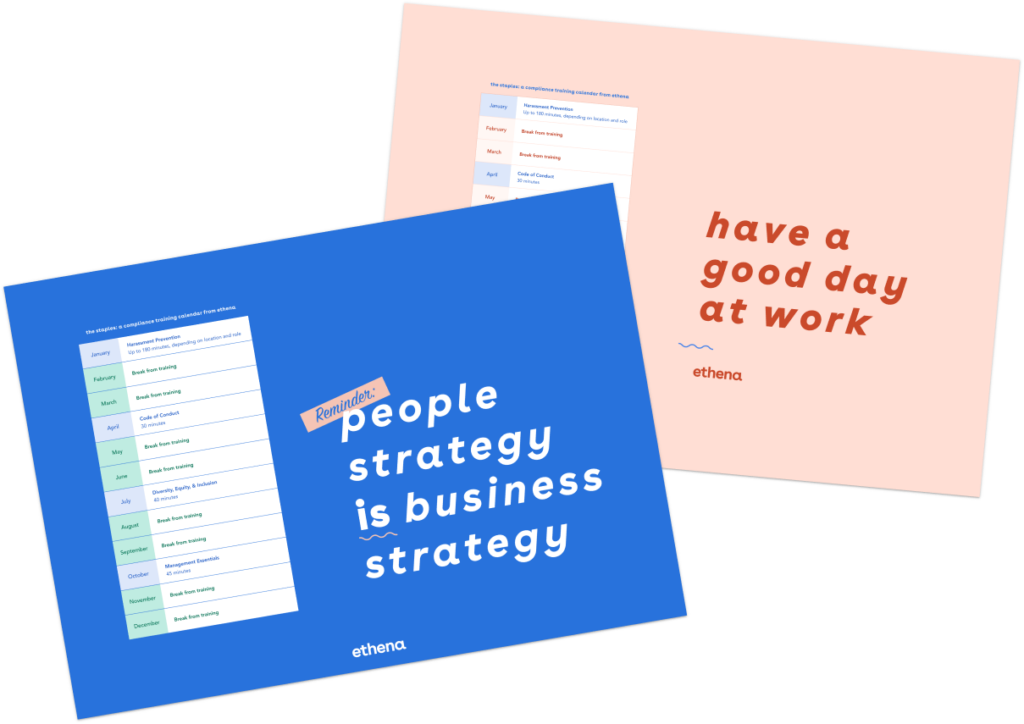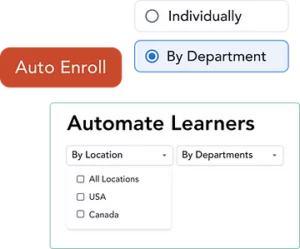We all know the feeling: it's time to roll out your company's annual compliance trainings, but employees aren't starting (or finishing) them. When HR pushes for higher completion rates, we often hear a variation of the following excuses in response:
- "Not enough time, sorry!"
- "The team’s got higher priorities to tackle."
- "I forgot."
We invest so much money in L&D, but how can we ensure our employees actually complete the trainings? Just because we build it, doesn’t mean they will come — in fact, research shows that completion rates for online training courses can be as low as four percent.
Effective training is critical to every company’s success. Whether it’s a manager training or a compliance-related training (i.e. Sexual Harassment Prevention), these trainings play a critical role in a variety of People-focused areas and throughout the employee life cycle, including:
- Culture-building
- Message signaling
- Growth and development
- Retention
- Risk mitigation
- And more
Employees know it, too. In fact, a 2019 LinkedIn study found that 94% of employees say they would stay at a company longer if the company invested in their development.
Why do companies struggle with participation rates on company-wide trainings?
But if employees are so hungry for growth and development, why is it so hard to get higher participation rates on company-wide trainings?
There are a few reasons why this might be.
- You haven’t made the connection for them: DEI training is development. So is Sexual Harassment Prevention. So is Unconscious Bias. These trainings do more than help us check a box; they teach both managers and individual contributors (ICs) their unique role in building a more ethical workplace.
- The training content is ineffective: We’ve all seen those anti-harassment trainings that look like they were made in the 80s and 90s. The examples are condescending, they’re ineffective, and they don’t cover the more relevant, gray area situations employees are most hungry to learn about. In other words, the trainings aren’t worth their time.
- There's a disconnect between what you say and what you do: Perhaps the training material doesn’t line up with the values or actions of your company. Or maybe you’re pushing for everyone to take the training only for employees to learn that leadership itself isn’t taking these trainings. If the company itself doesn’t stand by the material it’s putting out there, why should employees bother to take the time?

How to increase training completion rates
First and foremost, you’ll need to address any underlying issues at play, i.e. the ones listed above:
- Make it clear why these trainings are important and draw a clear connection between taking these trainings and their own personal growth and development. Ex: DEI training helping you be a more inclusive leader that will then be able to maximize on their team’s growth potential, being able to leverage unique strengths, adapt to different needs, etc.
- Invest in high-quality, effective trainings. Your employees’ time is valuable. (If you don’t believe that, just check with your head of finance. They could probably run a quick calculation on exactly just how valuable even one hour of the entire company’s time is worth. Spoiler alert: It’s a lot.) And your credibility as a company and People team is critical. Waste your team’s time with one bad training, and you’ll struggle to gain their trust the next time a training is due. Pick a training that aligns with your values and actually adds value with actionable insights and relevant topics.
- Get buy-in, alignment, and commitment from your leadership team. Have your manager reinforce the messaging around the importance of these trainings in their 1:1s.
3 creative ways to get your company to 100% completion
Once the above is all in place, here are a few fun, creative ways to really get your training completions to the next level:
1. Revisit your rollout strategy.
The cadence in which you're rolling out your courses — and how that aligns with your company's internal calendar – is critical.
When it comes to compliance training, it's important to be intentional with your rollout strategy. Make sure the training is being introduced at a time that works well for your team, so that you have less folks falling back on the excuse of, "Whoops! This is a really hectic time for sales. Not gonna happen."
Aside from factoring in the training the launch date, think about the deadline. Is this something that you want them to complete within a month? In six months? What's the deadline date going to be? Does it conflict with a major product launch or holiday?
Maybe October is a great time to launch for your business. But if your training deadline date is December 31st, you're not going to have and completing their training in the last week of the year. So making sure that you're really thoughtful around the scheduling of both the initial launch date as well as the deadline is key.
2. Make it a competition and offer fun prizes.
Give a prize to the first team that hits a 100% completion rate, or commit to a company-wide prize if the entire company gets to a 100% completion rate by a certain date. Prizes can be non-monetary (i.e. a 3-day weekend for the entire company) or monetary (i.e. expensed lunch for everyone). Bonus points if these incentives feed into your company values, like expensing lunch from a BIPOC-owned restaurant.
3. Host a few “watch parties”.
Virtual trainings can feel isolating. They also make it hard to find an hour or two to block out of your calendar to make them happen. Create an actual calendar event for employees to take the training at the same time and create a Slack channel so people can share their thoughts and questions live. Not only will it build a sense of community and learning together, it will also get others excited about the training and lead to fruitful discussions and insights for the leadership and People team.

4. Have your leadership team take the first wave of trainings.
Then, let them share their top takeaways and favorite parts. Culture starts at the top, and that’s no different when it comes to trainings. When employees see that leadership is invested and prioritizing compliance training, they’ll follow suit. Never underestimate the power of leadership buy-in.
Now, am I saying every training rollout needs to come paired with a company-wide competition and raffle prize? Not at all. Depending on your company size, needs, and culture, a simpler approach might be just as effective. Especially if you’ve already done the most important work, i.e. investing in high-quality training, getting leadership alignment and partnership, and, of course, connecting the dots for your employees on the importance of your trainings.
5. Carve out time (literally).
If your lagging completion rates are the result of a bandwidth issue, try blocking time for your teams to complete their training. Make it clear that they're allowed to decline meetings that are proposed during this block. At Ethena, we create company-wide calendar blocks for required training.
Why does this work?
Well, when employees have dedicated time for training, they're less likely to feel overwhelmed by their regular workload and the additional requirement of compliance training. Allocating specific time slots for training can help them manage their workload more effectively. Not to mention when employees know they have designated time to complete training, they can engage with the material more fully. That sounds like a win/win to us!
About Ethena
Ethena is a modern compliance training platform that delivers current, cringe-free content that employees actually enjoy. Request a sample course to see for yourself! If you’re ready to bring complex issues to life through thoughtful real-world examples, dynamic multimedia, and actionable next steps, let’s talk to see if Ethena is right for your company.









